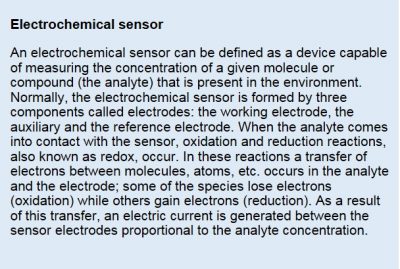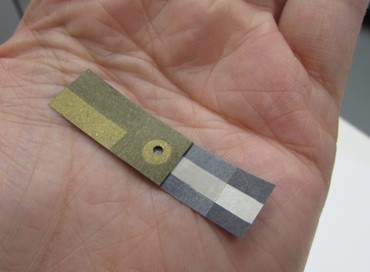[Paper: Direct Drawing Method of Graphite onto Paper for High-Performance Flexible Electrochemical Sensors. Santhiago, Murilo; Strauss, Mathias; Pereira, Mariane P.; Chagas, Andreia S.; Bufon, Carlos C. B. ACS Appl. Mater. Interfaces, 2017, 9 (13), pp 11959–11966. DOI: 10.1021/acsami.6b15646]
 Pencil and paper to make an electrochemical sensor
Pencil and paper to make an electrochemical sensor
Perhaps many of us have not thought of this before: painting a paper sheet with a graphite pencil creates, in addition to a drawing, a layer of electrically conductive material (graphite, made up of carbon atoms) on a flexible, inexpensive and widely available substrate (the paper). In other words, this extremely simple and quick method produces a very attractive platform for manufacturing sensors and other devices.
Based on this method of transferring graphite from pencil to paper, a team of Brazilian scientists developed a flexible electrochemical sensor. The device showed exceptional performance among similar sensors in the detection of a biological compound that is very difficult to detect , but also very relevant because it is present in all cells, fulfilling important functions in the metabolism of living beings.
The work was mostly carried out in the Brazilian Nanotechnology National Laboratory (LNNano) of the National Center for Research in Energy and Materials (CNPEM). Some analyses were conducted at the Multiuser Laboratory of Advanced Optical Spectroscopy of the Institute of Chemistry of UNICAMP, the State University of Campinas.

“One of the main contributions of the work was to show the efficiency of electrochemical devices prepared through a process of direct transfer of graphite on paper,” points out Carlos César Bof Bufon, corresponding author of a scientific article about the study, which was recently published in the journal ACS Applied Materials and Interfaces (impact factor = 7,504). Prof. Bufon and Dr. Murilo Santhiago lead the study, and all the authors are researchers of the Laboratory of Functional Devices and Systems at LNNano/CNPEM.
The work began with the aim of manufacturing carbon and/or hybrid electrochemical devices that would efficiently detect biological compounds, says Bufon. A survey of scientific literature showed the team of scientists that various types of carbon electrodes prepared through a wide variety of methods had already been reported, and that they all exchanged electrons very slowly when tested with some model molecules. In other words, for biological molecules they were not efficient electrochemical sensors. The team then chose the simplest carbon electrode preparation method (the pencil drawing) and decided to investigate why the material obtained did not show good results when used as an electrochemical sensor of these molecules. “We then decided to work on this issue by mapping the problems observed in other works and improving the aspects regarding the graphite surface”, states Santhiago.
The team was able to verify, for example, that the process of transferring graphite from pencil to paper left micro and nano debris on the surface of the electrode. To remove them, the researchers performed a quick electrochemical treatment on the electrode, which generated oxygen bubbles on the surface, which helped remove the debris and other impurities from the carbon film and push them away. “After this treatment, we found that the sensor response was one of the best for this type of material”, says Santhiago. To explain the exceptional performance, the scientists analyzed the carbon film before and after treatment using different materials characterization techniques and found that the electrochemical treatment generated changes in the structure and chemical composition of the carbon film surface.
After optimizing the paper-based carbon electrode, the team tested its ability to detect biological molecules and chose nicotinamide-adenine dinucleotide (NAD) as the analyte. This molecule is often used in tests, not only because of its relevance (it participates in more than 300 biological processes), but also because of the challenges of its detection. Therefore, the scientists had to make some adjustments in the electrode in order to make it more selective (to only detect NAD) and more sensitive (to detect small amounts of the molecule).

Then, the scientific team inserted on the surface of the electrode a compound that facilitates the transfer of electrons, the dye Meldola`s Blue. In the NAD detection tests, the final version of the sensor showed excellent performance, presenting the best results so far reported regarding the selectivity and speed of detection among paper-based electrodes. “Now, the simplest method is also the most efficient one, the one with the greatest application potential”, concludes Murilo Santhiago.
Following the success of manufacturing high-efficiency pencil-based graphite electrodes, the team continued its research on the subject. The scientists are now studying other applications of the material in electrochemical devices, including wearable ones, for the detection of species of biological and environmental interest. They are simultaneously working on the scalability of the manufacturing process to minimize small variations between devices – not a trivial point when we consider that the method is based on the manual use of a graphite pencil, among other manual processes. “Achieving scalability and high-efficiency materials at the same time is not always an easy task”, says Bufon, citing the example of graphene, which was initially isolated using adhesive tape through a simple and manual process, and with reproducibility problems.
The research was funded by CNPq and FAPESP, and used the infrastructure of the Brazilian National System of Nanotechnology Laboratories (SisNANO) at LNNano.

